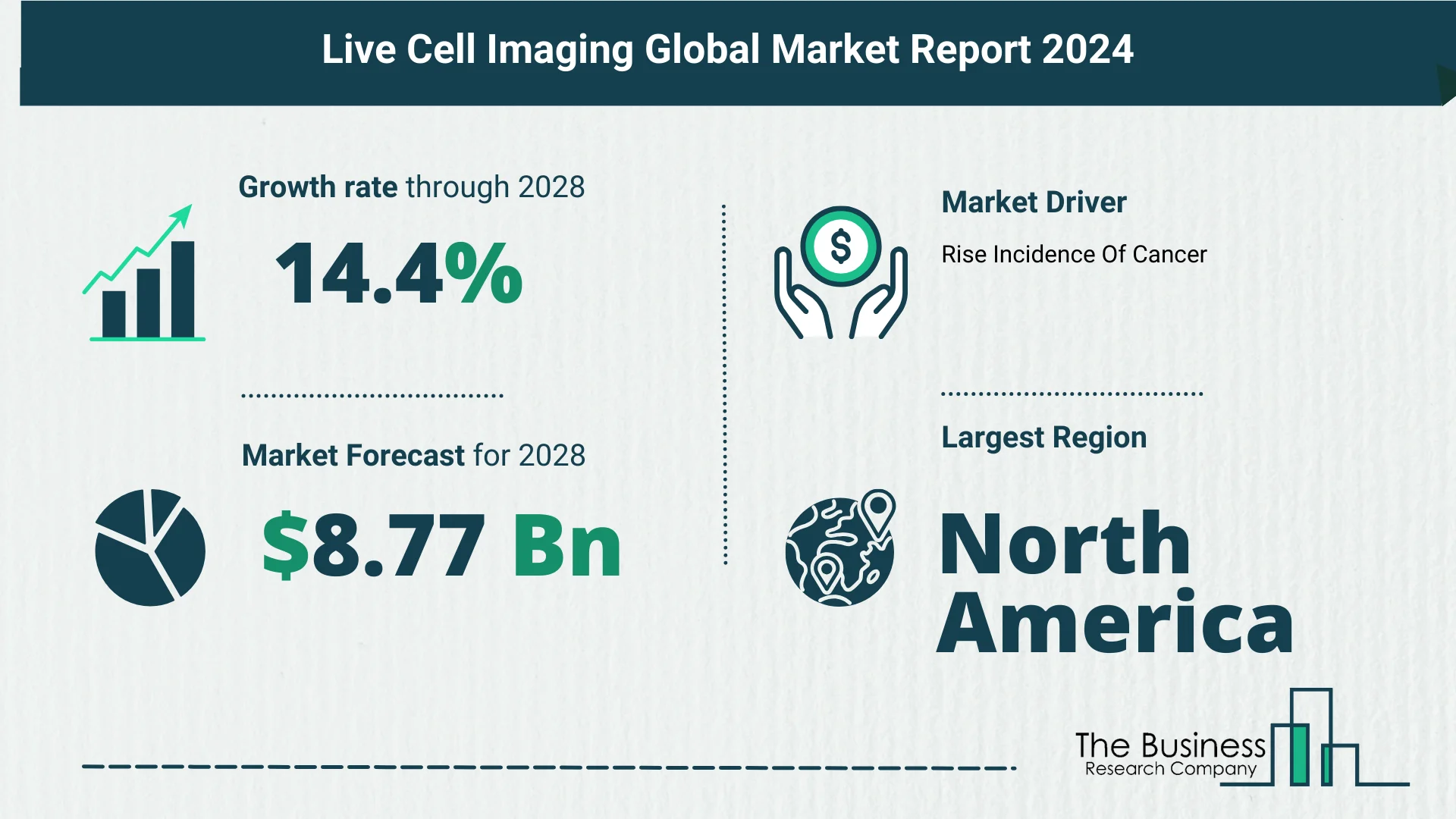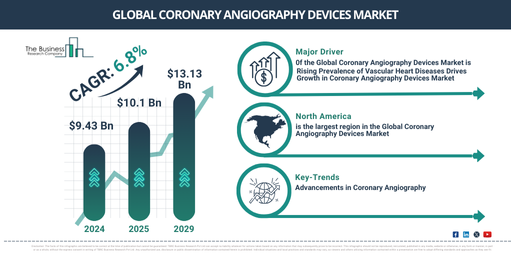Global Live Cell Imaging Market Key Insights 2024-2033
The Business Research Company’s global market reports are now updated with the latest market sizing information for the year 2024 and forecasted to 2033
According to The Business Research Company’s Live Cell Imaging Global Market Report 2024, the live cell imaging market is expected to show promising growth in the forecast period.
The live cell imaging market has experienced remarkable growth, catapulting from $4.43 billion in 2023 to a projected $5.11 billion in 2024, reflecting a compound annual growth rate (CAGR) of 15.4%. This expansion is attributed to pivotal factors such as drug discovery and development, cancer research, biotechnology, biopharmaceuticals, clinical applications, and cellular and molecular biology. Looking ahead, the market is poised for continued rapid growth, reaching $8.77 billion in 2028, with a CAGR of 14.4%. The forecasted surge is driven by infectious disease research, the adoption of personalized medicine, environmental and ecological research, and immunotherapy development. Notable trends in the forecast period include 3D and 4D imaging, super-resolution microscopy, high-content screening, live-cell tracking software, and the utilization of microfluidic devices.
Cancer Incidence as a Catalyst for Growth
The live cell imaging market is anticipated to experience a significant upswing due to the rising incidence of cancer. Globally, cancer stands as the second major cause of death, claiming one in every six lives annually. Projections indicate an increase to 29.5 million cancer cases and 16.4 million cancer-related deaths worldwide by 2040. In the United States alone, the number of cancer patients is expected to rise from 16.9 million in 2019 to 22.2 million by 2030. Live cell imaging technology plays a pivotal role in cancer immunotherapy advancement, allowing for visualization, characterization, and evaluation of the biological processes of living cells. Major companies contributing to this market include Leica Microsystems GmbH, Olympus Corporation, Sigma-Aldrich Corporation, and more.
- Major companies in the market include:
- Leica Microsystems GmbH
- Olympus Corporation
- Sigma-Aldrich Corporation
- PerkinElmer Inc.
- GE Healthcare Technologies Inc.
- And many more…
Increasing Focus on Next-Generation Live Cell Imaging
Innovation is at the forefront of major companies operating in the live cell imaging market, with a focus on developing next-generation products to drive revenues. An exemplary case is the CytoSMART Omni FL, a live-cell imaging analysis system introduced by CytoSMART Technologies. Launched in April 2022, this system incorporates red and green fluorescence channels into its signature CytoSMART Omni product line, producing high-quality, whole-well brightfield, or high-throughput fluorescence images of living cells. The device’s versatility allows scanning of various transparent cell culture vessels, from T75 flasks to microfluidic chips.
- CytoSMART Omni FL – A Next-Generation Live-Cell Imaging System
In April 2022, CytoSMART Technologies introduced CytoSMART Omni FL, a next-generation live-cell imaging analysis system. This innovative device incorporates red and green fluorescence channels into its product line, providing high-quality images of living cells.
View More On The Live Cell Imaging Market Report 2024 – https://www.thebusinessresearchcompany.com/report/live-cell-imaging-global-market-report
Axion Biosystems’ Strategic Acquisition of CytoSMART Technologies
In a strategic move in March 2022, Axion BioSystems, a US-based life sciences company, acquired CytoSMART Technologies for an undisclosed amount. This acquisition aims to propel Axion’s expansion in stem cell research and immuno-oncology. CytoSMART Technologies, based in the Netherlands, is recognized for its contributions to the live cell imaging domain.
- Strategic Acquisition – Axion Biosystems and CytoSMART Technologies
In March 2022, Axion BioSystems acquired CytoSMART Technologies, marking a strategic move to expand its presence in stem cell research and immuno-oncology.
Market Segmentation
The live cell imaging market is segmented based on key factors:
- Product:
- Equipment
- Consumable
- Software
- Technology:
- Time-Lapse Microscopy
- Fluorescence Recovery After Photobleaching (FRAP)
- Fluorescence Resonance Energy Transfer (FRET)
- High Content Screening (HCS)
- Other Technologies
- Application:
- Cell Biology
- Developmental Biology
- Stem Cell and Drug Discovery
- Other Applications
- End-User:
- Pharmaceutical and Biotechnology Companies
- Academic and Research Institutes
- Contract Research Organizations (CROs)
Regional Dynamics: North America Leading the Charge
In 2023, North America emerged as the largest region in the live cell imaging market, showcasing the region’s commitment to advancing life sciences and technology.
Conclusion
The live cell imaging market stands at the forefront of technological advancements, with a trajectory of sustained growth. Driven by the rising incidence of cancer and continuous innovation in imaging technologies, major companies are actively shaping the future of live cell imaging. As the market evolves, the integration of next-generation imaging solutions and strategic partnerships will play pivotal roles in defining the industry’s landscape, contributing to advancements in drug discovery, cancer research, and personalized medicine.
Request A Sample Of The Global Live Cell Imaging Market Report 2024:
https://www.thebusinessresearchcompany.com/sample_request?id=4110&type=smp



